Research Opportunity on Fractional Cover of Forest: A Bibliometric Review
Abstract
1. Introduction
- i.
- What is the current trend and significance of publications on the fractional cover of forests studies?
- ii.
- Which countries and authors are the most productive and prominent in the fractional cover of forest studies?
- iii.
- What are the frequent topics among scholars regarding the fractional cover of forests?
2. Materials and Methods
2.1. Documents Searching
- i.
- Bibliometrix 3.1 R-package for citation metrics and analysis [44].
- ii.
- VOSviewer version 1.6.16 (www.vosviewer.com, accessed on 15 May 2022) to create and visualise the bibliometric networks.
- iii.
- Microsoft Excel 365 was used to compute each publication’s citation frequency and percentage and create appropriate graphical representations.
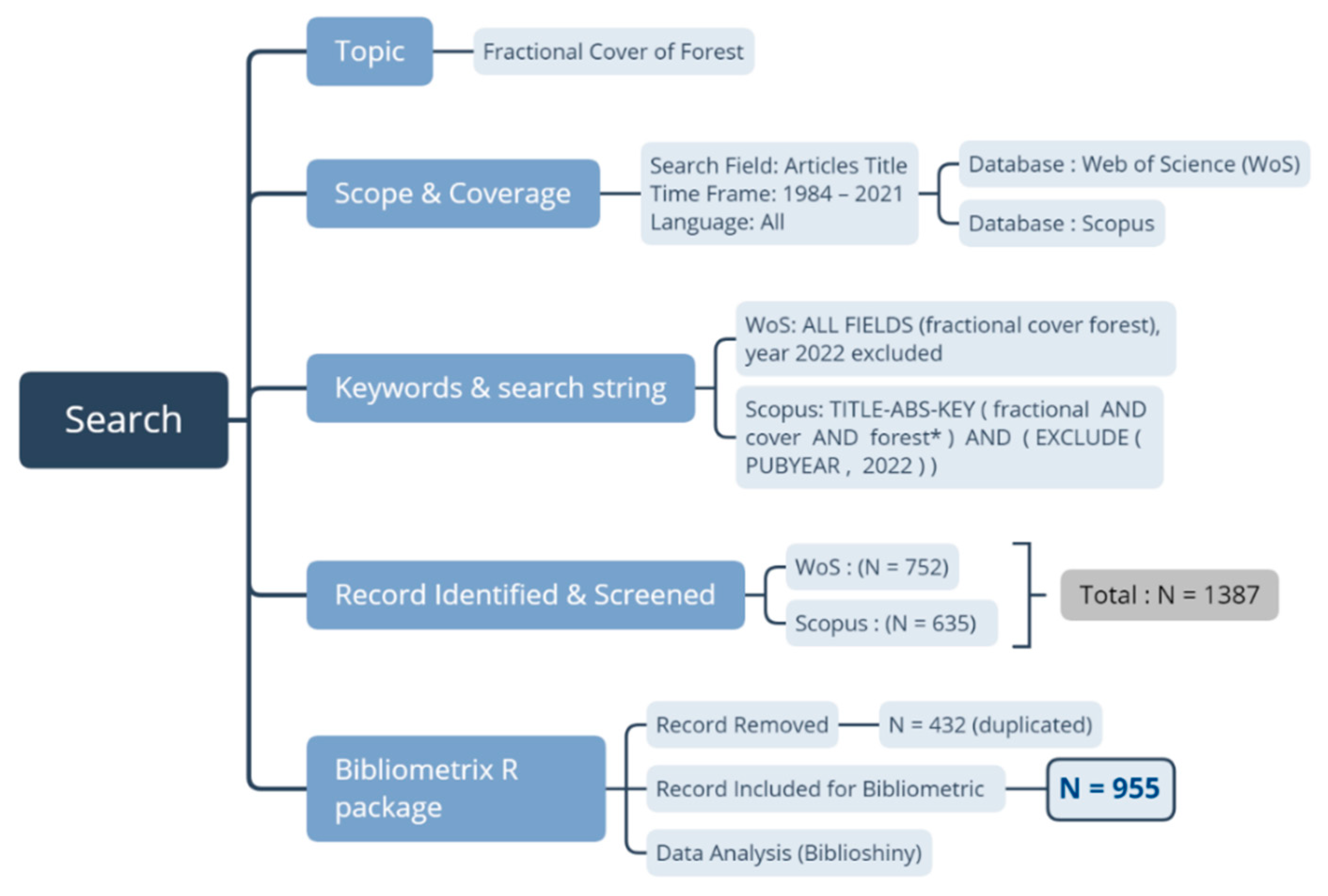
2.2. Bibliometric Analysis
2.2.1. Publication Current Trends
2.2.2. Most Productive Countries and Authors
2.2.3. Most Citations
3. Results and Discussion
3.1. Publication Current Trends
3.1.1. Publication Growth
3.1.2. Document and Source Type
3.1.3. Languages of Documents
3.2. Most Productive Countries and Authors
3.2.1. Publication by Countries
3.2.2. Authorship Analysis
3.3. Most Citation
3.3.1. Keywords Analysis
3.3.2. Citation Analysis
3.3.3. Publication by Source Title
3.3.4. Title and Abstract Analysis
4. Limitation of Study
5. Conclusions
Author Contributions
Funding
Acknowledgments
Conflicts of Interest
References
- FAO. Global Forest Resources Assessment 2020: Terms and Definitions. For. Resour. Assess. Work. Pap. 2020, 32. [Google Scholar]
- Chazdon, R.L.; Brancalion, P.H.S.; Laestadius, L.; Bennett-Curry, A.; Buckingham, K.; Kumar, C.; Moll-Rocek, J.; Vieira, I.C.G.; Wilson, S.J. When Is a Forest a Forest? Forest Concepts and Definitions in the Era of Forest and Landscape Restoration. Ambio 2016, 45, 538–550. [Google Scholar] [CrossRef] [PubMed]
- Ferretti-Gallon, K.; Busch, J. What Drives Deforestation and What Stops It? A Meta-Analysis of Spatially Explicit Econometric Studies. SSRN Electron. J. 2014, 11, 3–23. [Google Scholar] [CrossRef]
- Brodribb, T.; Powers, J.; Cochard, H.; Choat, B. Hanging by a Thread? Forests and Drought. Science 2020, 368, 261–266. [Google Scholar] [CrossRef] [PubMed]
- Malhi, Y.; Franklin, J.; Seddon, N.; Solan, M.; Turner, M.G.; Field, C.B.; Knowlton, N.; Solan, M.; Mg, T.; Cb, F.; et al. Climate Change and Ecosystems: Threats, Opportunities and Solutions. Trans. R. Soc. B 2020, 375, 20190104. [Google Scholar] [CrossRef] [PubMed]
- Xie, Y.; Peng, M. Forest Fire Forecasting Using Ensemble Learning Approaches. Neural Comput. Appl. 2019, 31, 4541–4550. [Google Scholar] [CrossRef]
- Nienhuis, S.; Wilson, R. Invasive Species in Ontario: The Threat, the Strategy, and the Law. For. Chron. 2018, 94, 97–102. [Google Scholar] [CrossRef]
- Linnakoski, R.; Kasanen, R.; Dounavi, A.; Forbes, K.M. Editorial: Forest Health Under Climate Change: Effects on Tree Resilience, and Pest and Pathogen Dynamics. Front. Plant Sci. 2019, 10, 1–3. [Google Scholar] [CrossRef]
- Trumbore, S.; Brando, P.; Hartmann, H. Forest Health and Global Change. Science 2015, 349, 814–818. [Google Scholar] [CrossRef]
- Steel, B.S. Deforestation and Forest Degradation. In Science and Politics: An A-to-Z Guide to Issues and Controversies; CQ Press: Washington, DC, USA, 2014. [Google Scholar] [CrossRef]
- World Wide Fund for Nature. Living Planet Report 2018: Aiming Higher; Grooten, M., Almond, R.E.A., WWF (Organization), Eds.; WWF—World Wide Fund for Nature: Gland, Switzerland, 2018; ISBN 978-2-940529-90-2. [Google Scholar]
- Zari, M.P. Utilizing Relationships between Ecosystem Services, Built Environments, and Building Materials; Elsevier Ltd.: Amsterdam, The Netherlands, 2017; ISBN 9780081007075. [Google Scholar]
- Li, Y.; Brando, P.M.; Randerson, J.T.; Morton, D.C.; Lawrence, D.M. Carbon Storage in Remaining Tropical Forests. Nat. Commun. 2022, 13, 1964. [Google Scholar] [CrossRef] [PubMed]
- Foley, J.A.; DeFries, R.; Asner, G.P.; Barford, C.; Bonan, G.; Carpenter, S.R.; Chapin, F.S.; Coe, M.T.; Daily, G.C.; Gibbs, H.K.; et al. Global Consequences of Land Use. Science 2005, 309, 570–574. [Google Scholar] [CrossRef] [PubMed]
- Gao, Y.; Skutsch, M.; Paneque-Gálvez, J.; Ghilardi, A. Remote Sensing of Forest Degradation: A Review. Environ. Res. Lett. 2020, 15, 103001. [Google Scholar] [CrossRef]
- Mansourian, S.; Howard, I.B.; Lake, F.K.; Parrotta, J.; Bhasme, S.; Balaji, P.; Bixler, R.P.; Sayer, J. Putting the Pieces Together: Integration for Forest Landscape Restoration Implementation. Land Degrad. Dev. 2020, 31, 419–429. [Google Scholar] [CrossRef]
- For, G.; Landscape, F.; In, R.; Tropics, T.H.E. Guidelines for Forest Landscape Restoration in the Tropics; International Tropical Timber Organization (ITTO): Yokohama, Japan, 2020; ISBN 9784865070644. [Google Scholar]
- Lausch, A.; Erasmi, S.; King, D.J.; Magdon, P.; Heurich, M. Understanding Forest Health with Remote Sensing -Part I—A Review of Spectral Traits, Processes and Remote-Sensing Characteristics. Remote Sens. 2016, 8, 1029. [Google Scholar] [CrossRef]
- Kamarulzaman, A.M.M.; Jaafar, W.S.W.M.; Maulud, K.N.A.; Saad, S.N.M.; Omar, H.; Mohan, M. Integrated Segmentation Approach with Machine Learning Classifier in Detecting and Mapping Post Selective Logging Impacts Using UAV Imagery. Forests 2022, 13, 48. [Google Scholar] [CrossRef]
- Koch, B. Remote Sensing Supporting National Forest Inventories NFA. In FAO Knowledge Reference for National Forest Assessments; FAO: Rome, Italy, 2013; pp. 1–18. [Google Scholar]
- Shanmugapriya, P.; Rathika, S.; Ramesh, T.; Janaki, P. Applications of Remote Sensing in Agriculture - A Review Applications of Remote Sensing in Agriculture—A Review. Int. J. Curr. Microbiol. App. Sci. 2019, 8, 2270–2283. [Google Scholar] [CrossRef]
- Lin, Y.; An, W.; Gan, M.; Shahtahmassebi, A.; Ye, Z.; Huang, L.; Zhu, C.; Huang, L.; Zhang, J.; Wang, K. Spatial Grain Effects of Urban Green Space Cover Maps on Assessing Habitat Fragmentation and Connectivity. Land 2021, 10, 1065. [Google Scholar] [CrossRef]
- Brown, L.A.; Ogutu, B.O.; Dash, J. Agricultural and Forest Meteorology Tracking Forest Biophysical Properties with Automated Digital Repeat Photography: A Fisheye Perspective Using Digital Hemispherical Photography from below the Canopy. Agric. For. Meteorol. 2020, 287, 107944. [Google Scholar] [CrossRef]
- Lechner, A.M.; Foody, G.M.; Boyd, D.S. Applications in Remote Sensing to Forest Ecology and Management. One Earth 2020, 2, 405–412. [Google Scholar] [CrossRef]
- Huete, A.R. Vegetation Indices, Remote Sensing and Forest Monitoring. Geogr. Compass 2012, 9, 513–532. [Google Scholar] [CrossRef]
- Jia, K.; Liang, S.; Liu, S.; Li, Y.; Xiao, Z.; Yao, Y. Estimation Using General Regression Neural. IEEE Trans. Geosci. Remote Sens. 2015, 53, 4787–4796. [Google Scholar] [CrossRef]
- Wang, X.; Jia, K.; Liang, S.; Zhang, Y. Fractional Vegetation Cover Estimation Method Through Dynamic Bayesian Network Combining Radiative Transfer Model and Crop Growth Model. IEEE Trans. Geosci. Remote Sens. 2016, 54, 7442–7450. [Google Scholar] [CrossRef]
- Hashim, M.; Pour, A.B.; Chong, K.W. Tropical Forest Degradation Monitoring Using ETM+ and MODIS Remote Sensing Data in the Peninsular Malaysia. IOP Conf. Ser. Earth Environ. Sci. 2014, 18, 012011. [Google Scholar] [CrossRef]
- Fisher, A.G.; Mills, C.H.; Lyons, M.; Cornwell, W.K. Remote Sensing of Trophic Cascades: Multi-Temporal Landsat Imagery Reveals Vegetation Change Driven by the Removal of an Apex Predator. Landsc. Ecol. 2021, 36, 1341–1358. [Google Scholar] [CrossRef]
- Pfeifer, M.; Kor, L.; Nilus, R.; Turner, E.; Cusack, J.; Lysenko, I.; Khoo, M.; Chey, V.K.; Chung, A.C.; Ewers, R.M. Remote Sensing of Environment Mapping the Structure of Borneo’s Tropical Forests across a Degradation Gradient. Remote Sens. Environ. 2016, 176, 84–97. [Google Scholar] [CrossRef]
- Forkuor, G.; Conrad, C.; Thiel, M.; Zoungrana, B.J. Multiscale Remote Sensing to Map the Spatial Distribution and Extent of Cropland in the Sudanian Savanna of West Africa. Remote Sens. 2017, 9, 839. [Google Scholar] [CrossRef]
- Gao, L.; Wang, X.; Alan, B.; Tian, Q.; Wang, Y.; Verrelst, J. ISPRS Journal of Photogrammetry and Remote Sensing Remote Sensing Algorithms for Estimation of Fractional Vegetation Cover Using Pure Vegetation Index Values: A Review. ISPRS J. Photogramm. Remote Sens. 2020, 159, 364–377. [Google Scholar] [CrossRef]
- Wang, B.; Waters, C.; Orgill, S.; Gray, J.; Cowie, A.; Clark, A.; Liu, D.L. Science of the Total Environment High Resolution Mapping of Soil Organic Carbon Stocks Using Remote Sensing Variables in the Semi-Arid Rangelands of Eastern Australia. Sci. Total Environ. 2018, 630, 367–378. [Google Scholar] [CrossRef]
- Tarigan, S.D. Land Cover Change and Its Impact on Flooding Frequency of Batanghari Watershed, Jambi Province, Indonesia. Procedia Environ. Sci. 2016, 33, 386–392. [Google Scholar] [CrossRef]
- Ghaffarian, S.; Kerle, N.; Filatova, T. Remote Sensing-Based Proxies for Urban Disaster Risk Management and Resilience: A Review. Remote Sens. 2018, 10, 1760. [Google Scholar] [CrossRef]
- Villarreal, M.L.; Norman, L.M.; Buckley, S.; Wallace, C.S.A.; Coe, M.A. Remote Sensing of Environment Multi-Index Time Series Monitoring of Drought and Fi Re Effects on Desert Grasslands. Remote Sens. Environ. 2016, 183, 186–197. [Google Scholar] [CrossRef]
- Asner, G.P.; Knapp, D.E.; Cooper, A.N.; Bustamante, M.M.C.; Olander, L.P. Ecosystem Structure throughout the Brazilian Amazon from Landsat Observations and Automated Spectral Unmixing. Earth Interact. 2005, 9, 1–31. [Google Scholar] [CrossRef]
- Sensing, A.R.; Edition, S. Fractional Vegetation Cover; Elsevier Ltd.: Amsterdam, The Netherlands, 2020; ISBN 9780128158265. [Google Scholar]
- Chen, T.H.; Henderson-Sellers, A.; Milly, P.C.D.; Pitman, A.J.; Beljaars, A.C.M.; Polcher, J.; Abramopoulos, F.; Boone, A.; Chang, S.; Chen, F.; et al. Cabauw Experimental Results from the Project for Intercomparison of Land-Surface Parameterization Schemes. J. Clim. 1997, 10, 1194–1215. [Google Scholar] [CrossRef]
- Jia, K.; Liang, S.; Wei, X.; Li, Q.; Du, X.; Jiang, B.; Yao, Y.; Zhao, X.; Li, Y. Fractional Forest Cover Changes in Northeast China from 1982 to 2011 and Its Relationship with Climatic Variations. IEEE J. Sel. Top. Appl. Earth Obs. Remote Sens. 2015, 8, 775–783. [Google Scholar] [CrossRef]
- Ismail, S.; Nason, E.; Marjanovic, S.; Grant, J. Bibliometrics as a Tool for Supporting Prospective R&D Decision-Making in the Health Sciences: Strengths, Weaknesses and Options for Future Development. Rand Health Q. 2012, 1, 11. [Google Scholar] [PubMed]
- Waltman, L.; Noyons, E. Bibliometrics for Research Management and Research Evaluation: A Brief Introduction. Cwts 2018, 24. [Google Scholar]
- Uribe-Toril, J.; Ruiz-Real, J.L.; Haba-Osca, J.; de Pablo Valenciano, J. Forests’ First Decade: A Bibliometric Analysis Overview. Forests 2019, 10, 72. [Google Scholar] [CrossRef]
- Aria, M.; Cuccurullo, C. Bibliometrix: An R-Tool for Comprehensive Science Mapping Analysis. J. Informetr. 2017, 11, 959–975. [Google Scholar] [CrossRef]
- Newman, I.; Covrig, D.M. Building Consistency between Title, Problem Statement, Purpose, & Research Questions to Improve the Quality of Research Plans and Reports. New Horiz. Adult Educ. Hum. Resour. Dev. 2013, 25, 70–79. [Google Scholar] [CrossRef]
- Dewan, P.; Gupta, P. Writing the Title, Abstract and Introduction: Looks Matter! Indian Pediatr. 2016, 53, 235–241. [Google Scholar] [CrossRef] [PubMed]
- Padberg, M.W.; Wolsey, L.A. Fractional Covers for Forests and Matchings. Math. Program. 1984, 29, 1–14. [Google Scholar] [CrossRef]
- Sweileh, W.M.; Al-Jabi, S.W.; AbuTaha, A.S.; Zyoud, S.H.; Anayah, F.M.A.; Sawalha, A.F. Bibliometric Analysis of Worldwide Scientific Literature in Mobile—Health: 2006-2016. BMC Med. Inform. Decis. Mak. 2017, 17, 1–12. [Google Scholar] [CrossRef] [PubMed]
- Godutti, D. Biology Concepts and Challenges. Available online: https://legacy.cnx.org/content/col11665/1.1 (accessed on 23 September 2022).
- He, D.; Cao, S.; Le, Y.; Chen, Y.; Wang, M.; Qian, B. A Bibliometric Analysis of Application of VR Technologies in Stroke Rehabilitation from 2001 to 2021 in China. In Proceedings of the 2nd International Symposium on Artificial Intelligence for Medicine Sciences, Beijing, China, 29–31 October 2021. [Google Scholar] [CrossRef]
- Choi, J.; Yi, S.; Lee, K.C. Analysis of Keyword Networks in MIS Research and Implications for Predicting Knowledge Evolution. Inf. Manag. 2011, 48, 371–381. [Google Scholar] [CrossRef]
- Lazonder, A.W.; Janssen, N. Quotation Accuracy in Educational Research Articles. Educ. Res. Rev. 2021, 35, 100430. [Google Scholar] [CrossRef]
- Norman, J.M.; Kustas, W.P.; Humes, K.S. Source Approach for Estimating Soil and Vegetation Energy Fluxes in Observations of Directional Radiometric Surface Temperature. Agric. For. Meteorol. 1995, 77, 263–293. [Google Scholar] [CrossRef]
- Steduto, P.; Hsiao, T.C.; Raes, D.; Fereres, E. Aquacrop-the FAO Crop Model to Simulate Yield Response to Water: I. Concepts and Underlying Principles. Agron. J. 2009, 101, 426–437. [Google Scholar] [CrossRef]
- Kumar, P.; Foufoula-Georgiou, E. Wavelet Analysis for Geophysical Applications. Rev. Geophys. 1997, 35, 385–412. [Google Scholar] [CrossRef]
- Glenn, E.P.; Huete, A.R.; Nagler, P.L.; Nelson, S.G. Relationship between Remotely-Sensed Vegetation Indices, Canopy Attributes and Plant Physiological Processes: What Vegetation Indices Can and Cannot Tell Us about the Landscape. Sensors 2008, 8, 2136–2160. [Google Scholar] [CrossRef] [PubMed]
- Somers, B.; Asner, G.P.; Tits, L.; Coppin, P. Endmember Variability in Spectral Mixture Analysis: A Review. Remote Sens. Environ. 2011, 115, 1603–1616. [Google Scholar] [CrossRef]
- Walko, R.L.; Band, L.E.; Baron, J.; Kittel, T.G.F.; Lammers, R.; Lee, T.J.; Ojima, D.; Pielke, R.A.; Taylor, C.; Tague, C.; et al. Coupled Atmosphere–Biophysics–Hydrology Models for Environmental Modeling. J. Appl. Meteorol. 2000, 39, 931–944. [Google Scholar] [CrossRef]
- Painter, T.H.; Rittger, K.; McKenzie, C.; Slaughter, P.; Davis, R.E.; Dozier, J. Retrieval of Subpixel Snow Covered Area, Grain Size, and Albedo from MODIS. Remote Sens. Environ. 2009, 113, 868–879. [Google Scholar] [CrossRef]
- Dennison, P.E.; Roberts, D.A. Endmember Selection for Multiple Endmember Spectral Mixture Analysis Using Endmember Average RMSE. Remote Sens. Environ. 2003, 87, 123–135. [Google Scholar] [CrossRef]
- Panagos, P.; Borrelli, P.; Meusburger, K.; Alewell, C.; Lugato, E.; Montanarella, L. Estimating the Soil Erosion Cover-Management Factor at the European Scale. Land Use Policy 2015, 48, 38–50. [Google Scholar] [CrossRef]
- Ducoudré, N.I.; Laval, K.; Perrier, A. SECHIBA, a New Set of Parameterizations of the Hydrologic Exchanges at the Land-Atmosphere Interface within the LMD Atmospheric General Circulation Model. J. Clim. 1993, 6, 248–273. [Google Scholar] [CrossRef]
- Pfirrman, S.J.; Yheulon, C.G.; Parziale, J.R. The Hirsch Index and Self-Citation in Academic Physiatry among Graduate Medical Education Program Directors. Am. J. Phys. Med. Rehabil. 2022, 101, 294–297. [Google Scholar] [CrossRef] [PubMed]
- Mitchell, A.L.; Rosenqvist, A.; Mora, B. Current Remote Sensing Approaches to Monitoring Forest Degradation in Support of Countries Measurement, Reporting and Verification (MRV) Systems for REDD+. Carbon Balance Manag. 2017, 12, 9. [Google Scholar] [CrossRef]
- Hoscilo, A.; Zagajewski, B.; Mouketou-tarazewicz, D. Assessment of Sentinel-2 Satellite Images and Random Forest Classifier for Assessment of Sentinel-2 Satellite Images and Random Forest Classifier for Rainforest Mapping in Gabon. Forests 2020, 11, 941. [Google Scholar] [CrossRef]
- Mohan, M.; Leite, R.V.; Broadbent, E.N.; Wan Mohd Jaafar, W.S.; Srinivasan, S.; Bajaj, S.; Dalla Corte, A.P.; do Amaral, C.H.; Gopan, G.; Saad, S.N.M.; et al. Individual Tree Detection Using UAV-Lidar and UAV-SfM Data: A Tutorial for Beginners. Open Geosci. 2021, 13, 1028–1039. [Google Scholar] [CrossRef]
- Ab Rahman, A.A.; Wan Mohd Jaafar, W.S.; Abdul Maulud, K.N.; Noor, N.M.; Mohan, M.; Cardil, A.; Silva, C.A.; Che’Ya, N.N.; Naba, N.I. Applications of Drones in Emerging Economies: A Case Study of Malaysia. In Proceedings of the 2019 6th International Conference on Space Science and Communication (IconSpace), Johor Bahru, Malaysia, 28–30 July 2019; pp. 35–40. [Google Scholar]
- Indarto, J.; Mutaqin, D.J. An Overview of Theoretical and Empirical Studies on Deforestation. J. Int. Dev. Coop. 2016, 22, 107–120. [Google Scholar] [CrossRef]
- Siti-Nor-Maizah, S.; Wan-Shafrina, W.; Khairul-Nizam, A.; Aisyah-Marliza, M.; Hamdan, O. Determination of Emission Factor from Logging Operations in Ulu Jelai Forest Reserve, Pahang Using the Integration of UAV and High Resolution Imageries. JTFS 2022, 34, 247–257. [Google Scholar] [CrossRef]
- UNFCCC. Report of the Conference of the Parties on Its Fifteenth Session, Held in Copenhagen from 7 to 19 December 2009. Available online: https://unfccc.int/resource/docs/2009/cop15/eng/11a01.pdf (accessed on 15 May 2022).

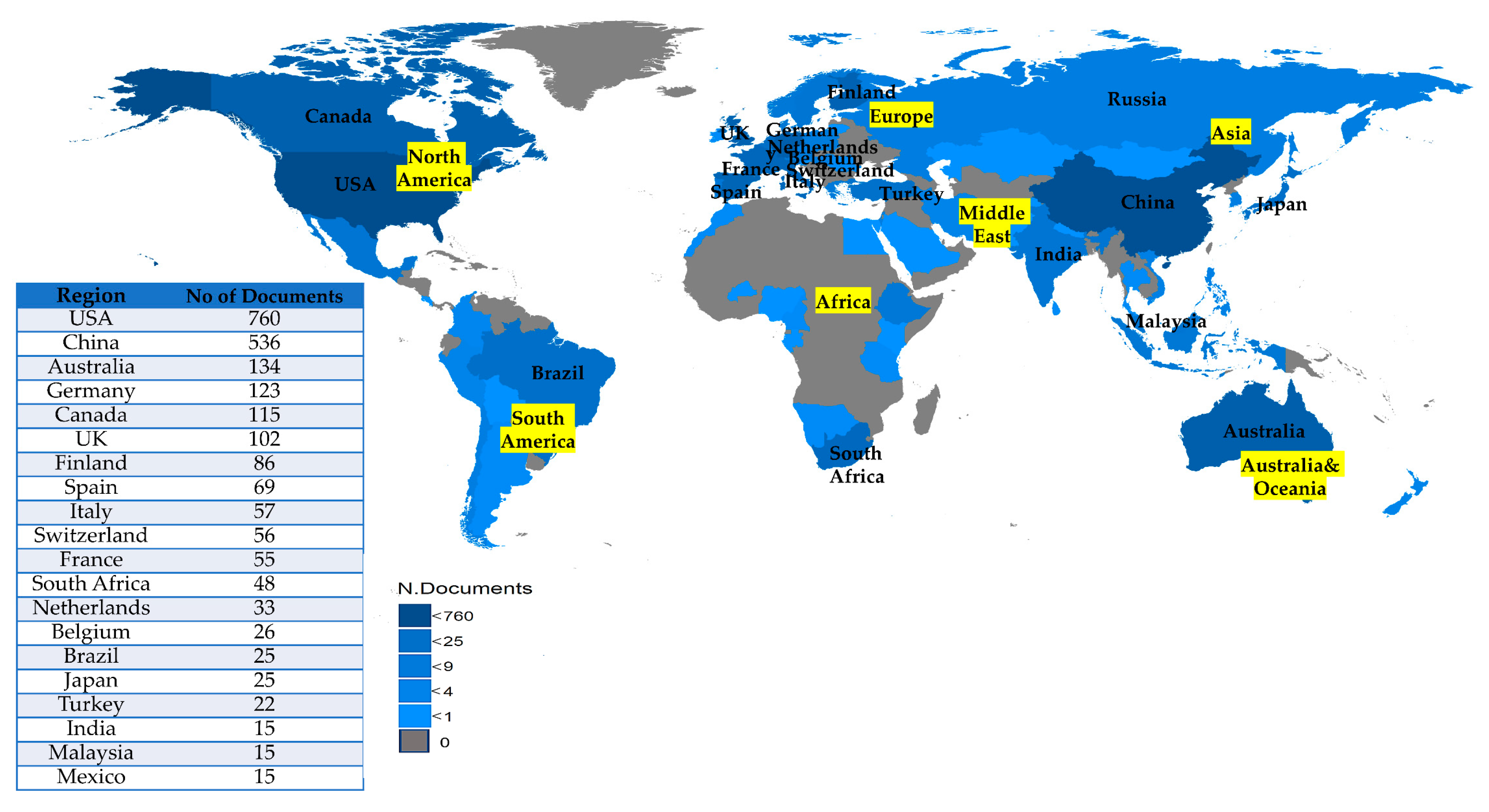

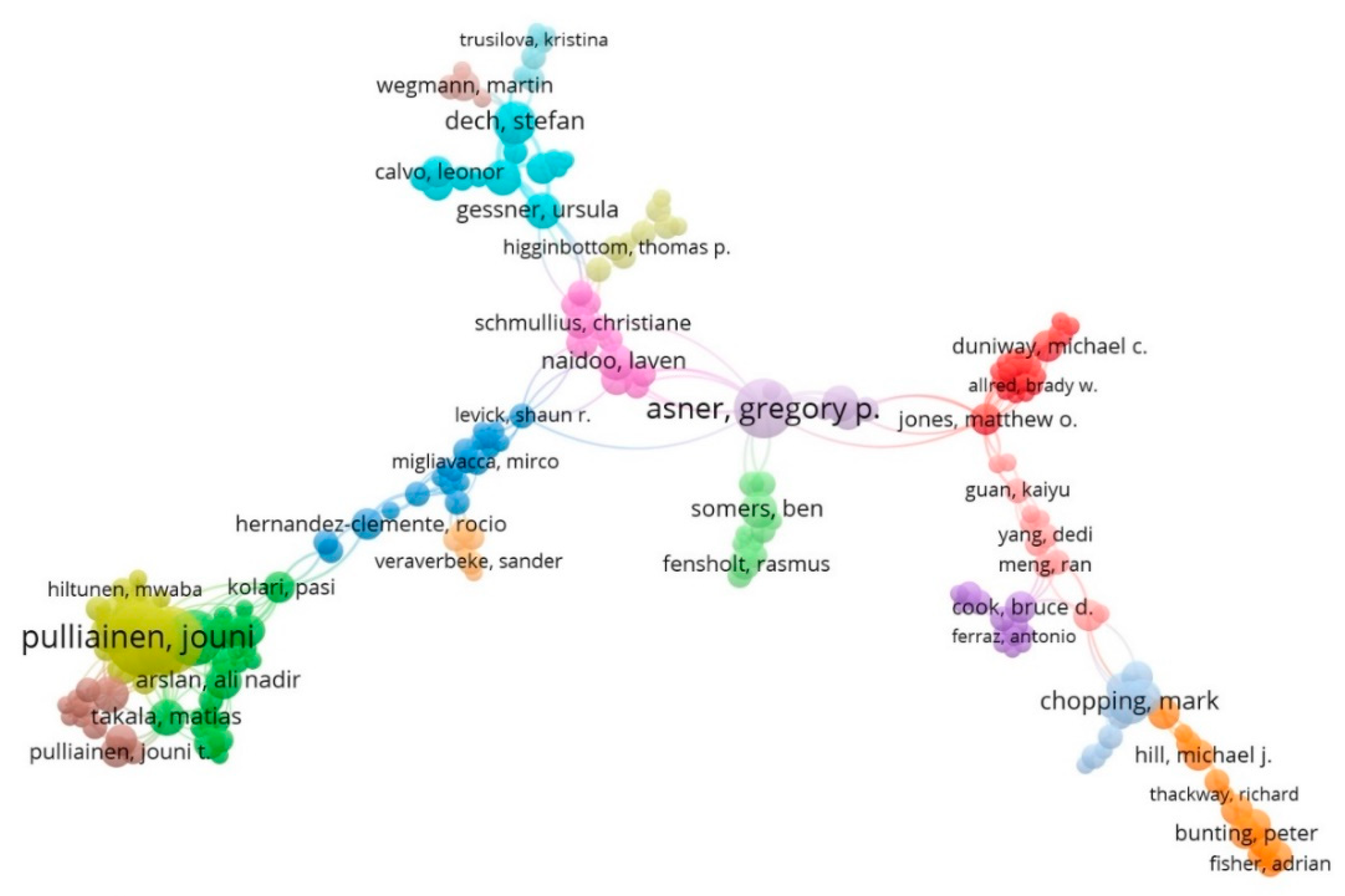
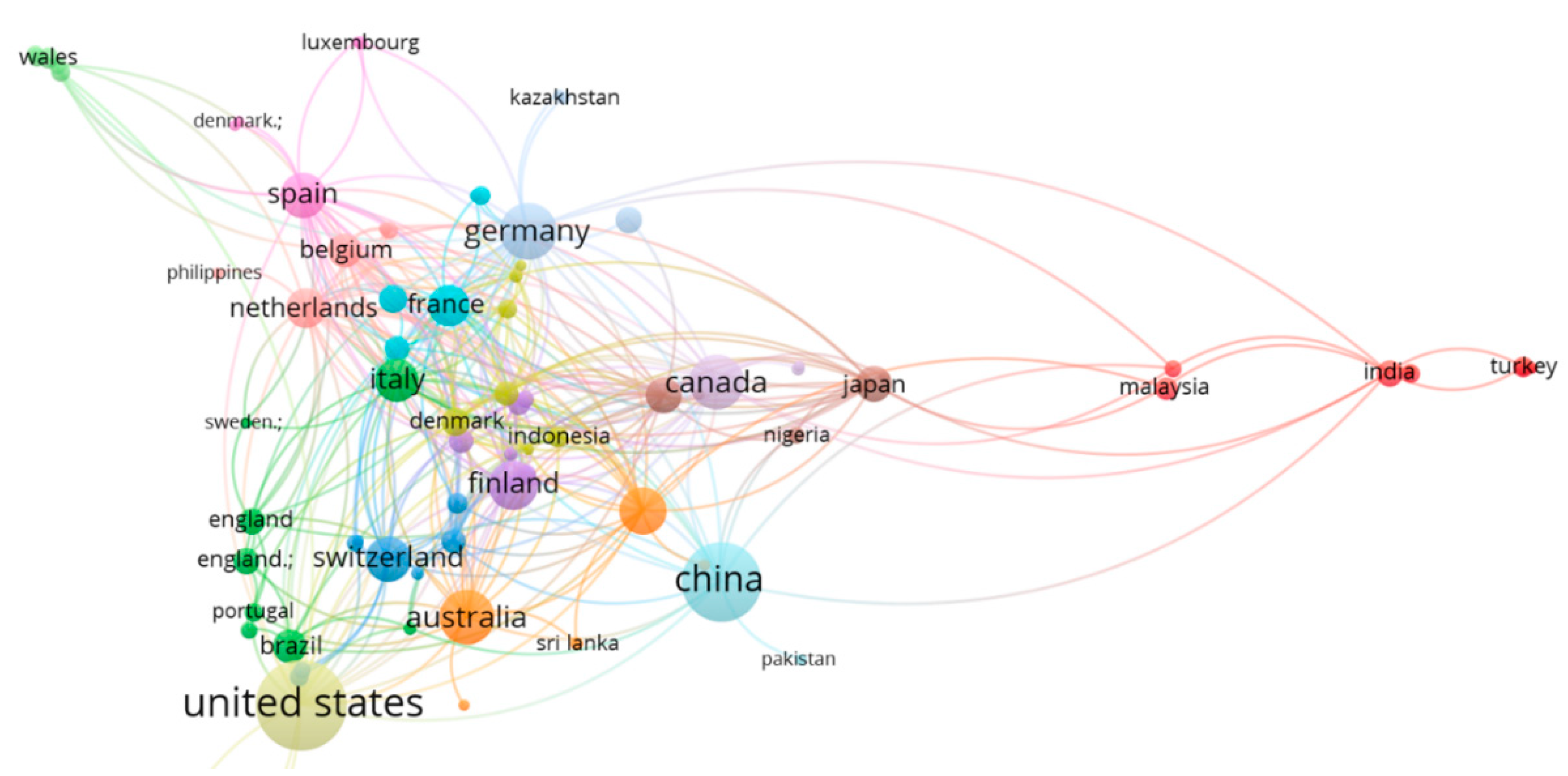
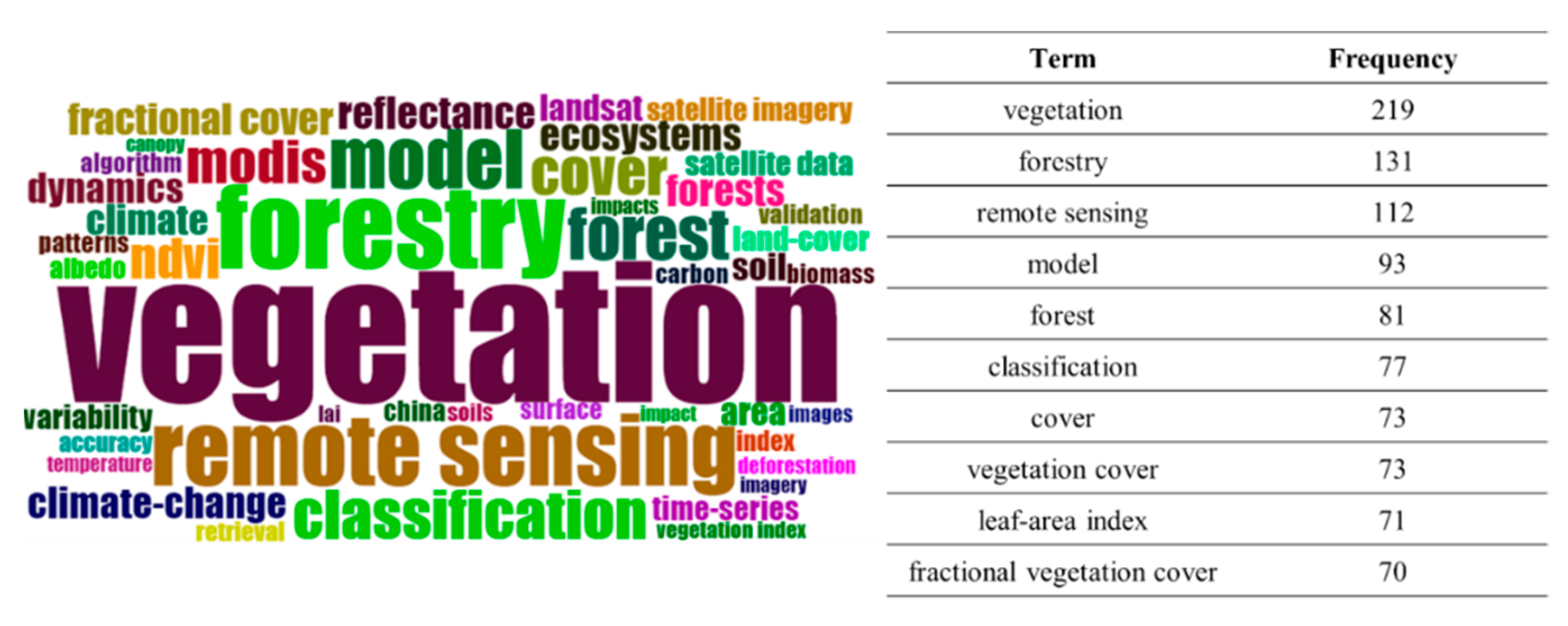
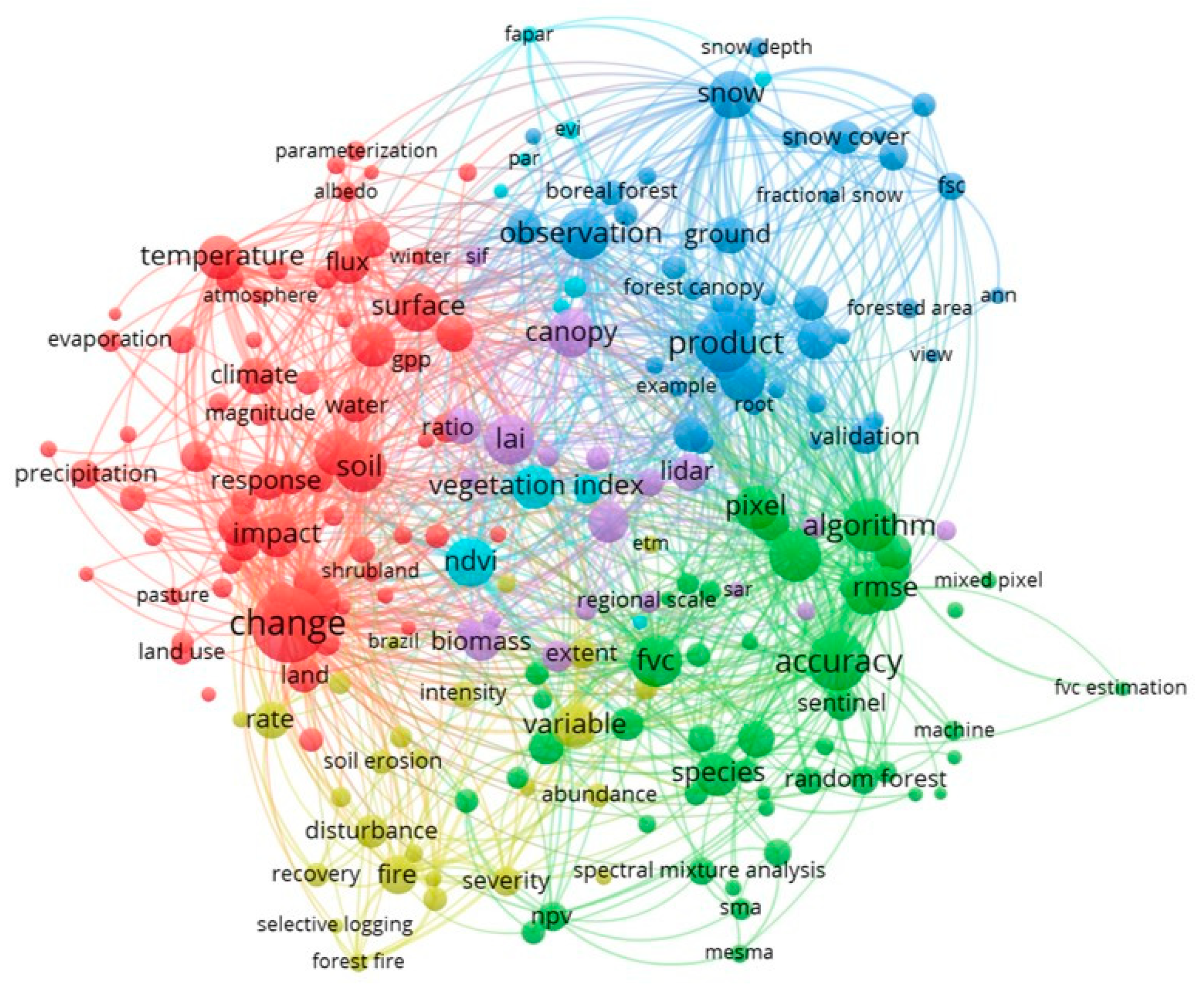
| Document Types | Total Publications | % |
|---|---|---|
| article | 787 | 82.41 |
| article: book chapter | 4 | 0.42 |
| article: data paper | 3 | 0.31 |
| article: early access | 4 | 0.42 |
| article: proceedings paper | 13 | 1.36 |
| book chapter | 6 | 0.63 |
| conference paper | 56 | 5.86 |
| conference review | 4 | 0.42 |
| erratum | 1 | 0.10 |
| proceedings paper | 65 | 6.81 |
| review | 11 | 1.15 |
| short survey | 1 | 0.10 |
| Total | 955 | 100.00 |
| Language | Total Publications | (%) |
|---|---|---|
| English | 924 | 96.75 |
| Chinese | 25 | 2.62 |
| French | 1 | 0.10 |
| Polish | 2 | 0.21 |
| Russian | 1 | 0.10 |
| Spanish | 2 | 0.21 |
| Total | 955 | 100.00 |
| Authors | Articles | Articles Fractionalized * | Affiliation | Country |
|---|---|---|---|---|
| Xiao-Yan Li | 22 | 4.33 | Beijing Normal University | China |
| Gregory P. Asner | 21 | 5.20 | Carnegie Institution | The USA |
| Jouni Pulliainen | 21 | 3.62 | Finnish Meteorological Institute | Finland |
| Jinfei Wang | 21 | 4.27 | Beijing Normal University | China |
| Sari Metsämäki | 17 | 3.17 | Finnish Meteorological Institute | Finland |
| Yongguang Zhang | 16 | 2.62 | Nanjing University | China |
| Kari Luojus | 13 | 2.38 | Finnish Meteorological Institute | Finland |
| Dar A. Roberts | 12 | 2.99 | University of California | The USA |
| Yunjun Yao | 12 | 1.71 | Beijing Normal University | China |
| Kun Jia | 11 | 1.30 | Beijing Normal University | China |
| Item | Description | Results |
|---|---|---|
| Main Information About Data | Timespan | 1984–2021 |
| Sources (Journals, Books, etc.) | 325 | |
| Documents | 955 | |
| Average years from publication | 8.53 | |
| Average citations per document | 28.93 | |
| Average citations per year per document | 2.898 | |
| References | 3.6374 | |
| Authors Collaboration | Single-authored documents | 44 |
| Documents per Author | 0.328 | |
| Authors per Document | 3.05 | |
| Co-Authors per Documents | 4.77 | |
| Collaboration Index | 3.15 |
| No. | Paper | Article | TC | TC per Year | Normalised TC |
|---|---|---|---|---|---|
| 1 | Norman J.M. et al. [53] | Source approach for estimating soil and vegetation energy fluxes in observations of directional radiometric surface temperature | 1044 | 37.29 | 5.49 |
| 2 | Steduto P. et al. [54] | AquaCrop—The FAO crop model to simulate yield response to water: I. concepts and underlying principles | 935 | 66.79 | 11.42 |
| 3 | Kumar P. and Foufoula-Georgiou [55] | Wavelet analysis for geophysical applications | 666 | 25.62 | 5.69 |
| 4 | Glenn E.P. et al. [56] | Relationship between remotely-sensed vegetation indices, canopy attributes and plant physiological processes: What vegetation indices can and cannot tell us about the landscape | 445 | 29.67 | 8.74 |
| 5 | Somers B. et al. [57] | Endmember variability in Spectral Mixture Analysis: A review | 440 | 36.67 | 10.54 |
| 6 | Walko R.L. et al. [58] | Coupled atmosphere–biophysics–hydrology models for environmental modelling | 420 | 18.26 | 5.19 |
| 7 | Painter T.H. et al. [59] | Retrieval of subpixel snow-covered area, grain size, and albedo from MODIS | 361 | 25.79 | 4.41 |
| 8 | Dennison P.E. and Roberts D.A. [60] | Endmember selection for multiple endmember spectral mixture analysis using endmember average RMSE | 323 | 16.15 | 4.29 |
| 9 | Panagos P. et al. [61] | Estimating the soil erosion cover-management factor at the European scale | 314 | 39.25 | 10.10 |
| 10 | Ducoudre N.I. et al. [62] | SECHIBA, a new set of parameterizations of the hydrologic exchanges at the land-atmosphere interface within the LMD. Atmospheric General Circulation Model | 306 | 10.20 | 2.92 |
| Sources Title | Publisher | TP | TC | h-Index |
|---|---|---|---|---|
| Remote Sensing of Environment | Elsevier | 133 | 7585 | 51 |
| Remote Sensing | MDPI | 78 | 1165 | 20 |
| Agricultural and Forest Meteorology | Elsevier | 42 | 2790 | 22 |
| International Journal of Remote Sensing | Taylor & Francis Ltd | 38 | 855 | 18 |
| International Journal of Applied Earth Observation and Geoinformation | Elsevier | 36 | 1068 | 19 |
| ISPRS Journal of Photogrammetry and Remote Sensing | Elsevier | 23 | 724 | 14 |
| IEEE Journal of Selected Topics In Applied Earth Observations And Remote Sensing | IEEE-Inst Electrical and Electronics Engineers Inc. | 14 | 136 | 8 |
| IEEE Transactions on Geoscience and Remote Sensing | IEEE-Inst Electrical Electronics Engineers Inc. | 14 | 320 | 10 |
| Water Resources Research | American Geophysical Union | 10 | 185 | 8 |
| Ecological Indicators | Elsevier | 9 | 209 | 5 |
Publisher’s Note: MDPI stays neutral with regard to jurisdictional claims in published maps and institutional affiliations. |
© 2022 by the authors. Licensee MDPI, Basel, Switzerland. This article is an open access article distributed under the terms and conditions of the Creative Commons Attribution (CC BY) license (https://creativecommons.org/licenses/by/4.0/).
Share and Cite
Mohd Ghazali, N.; Said, M.N.M.; Wan Mohd Jaafar, W.S.; Muhmad Kamarulzaman, A.M.; Saad, S.N.M. Research Opportunity on Fractional Cover of Forest: A Bibliometric Review. Forests 2022, 13, 1664. https://doi.org/10.3390/f13101664
Mohd Ghazali N, Said MNM, Wan Mohd Jaafar WS, Muhmad Kamarulzaman AM, Saad SNM. Research Opportunity on Fractional Cover of Forest: A Bibliometric Review. Forests. 2022; 13(10):1664. https://doi.org/10.3390/f13101664
Chicago/Turabian StyleMohd Ghazali, Norzalyta, Mohd Nizam Mohd Said, Wan Shafrina Wan Mohd Jaafar, Aisyah Marliza Muhmad Kamarulzaman, and Siti Nor Maizah Saad. 2022. "Research Opportunity on Fractional Cover of Forest: A Bibliometric Review" Forests 13, no. 10: 1664. https://doi.org/10.3390/f13101664
APA StyleMohd Ghazali, N., Said, M. N. M., Wan Mohd Jaafar, W. S., Muhmad Kamarulzaman, A. M., & Saad, S. N. M. (2022). Research Opportunity on Fractional Cover of Forest: A Bibliometric Review. Forests, 13(10), 1664. https://doi.org/10.3390/f13101664






